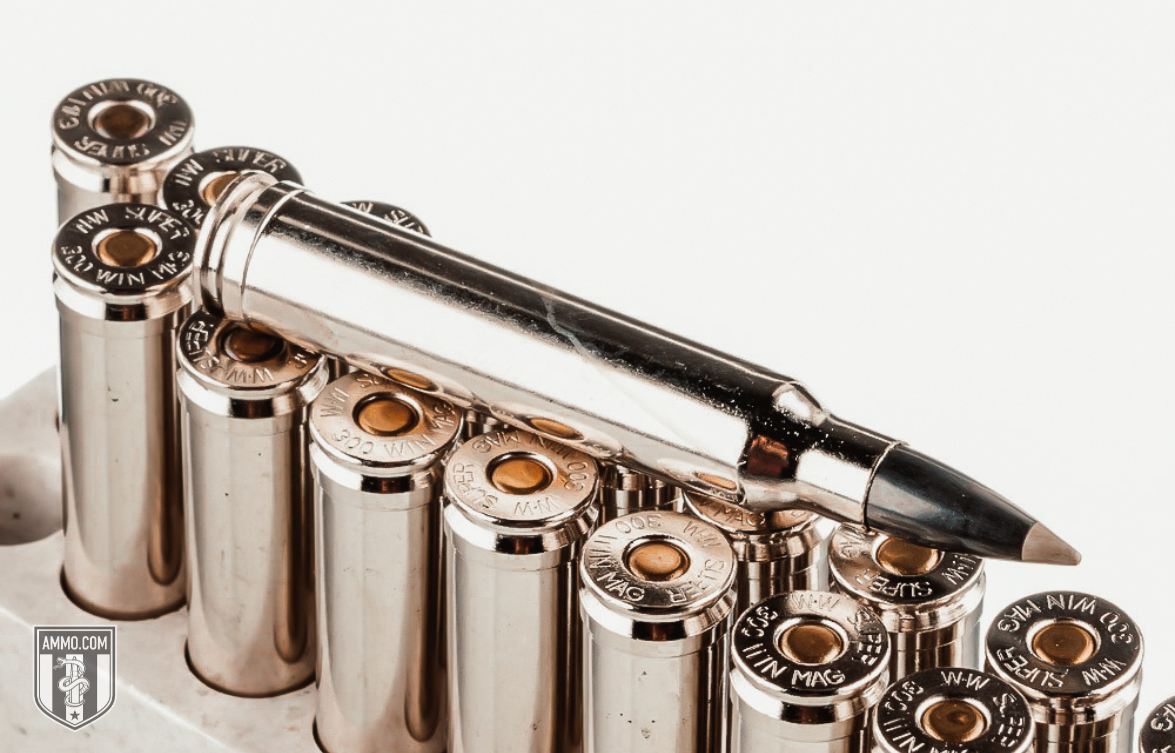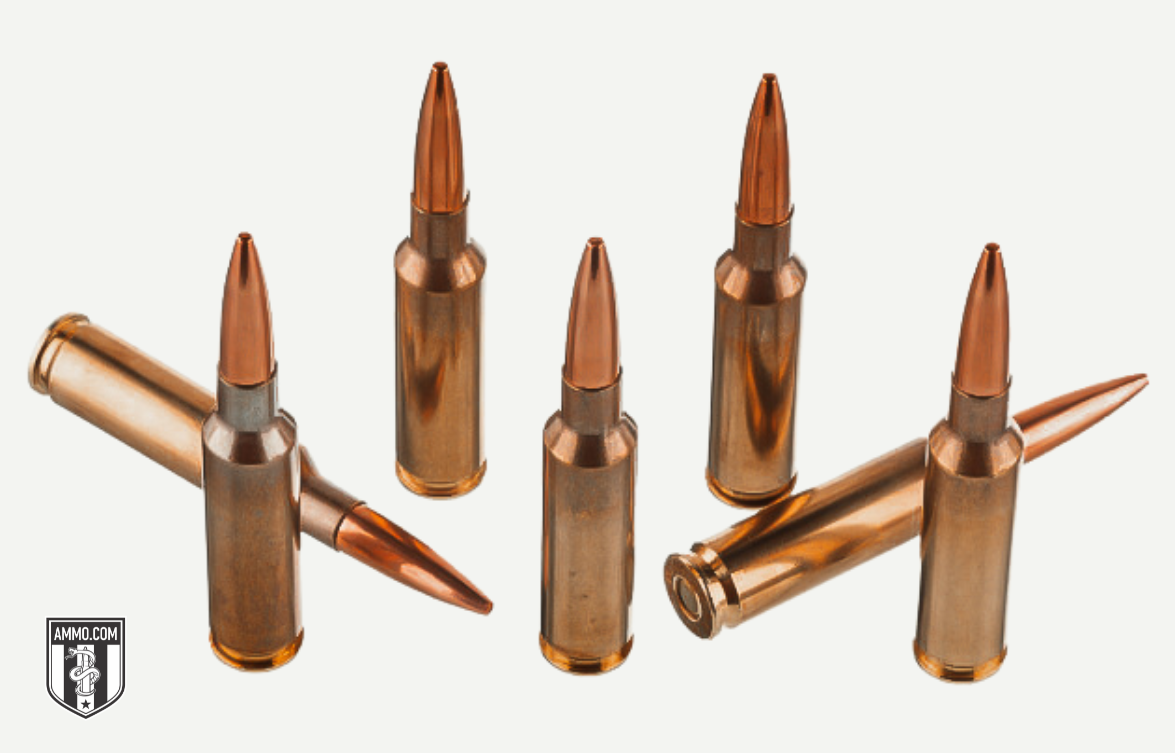6.5 Creedmoor vs. 300 Win Mag: Is a Magnum Cartridge Really Better?
The 6.5 Creedmoor took the long-range shooting world by storm for many reasons. Is having comparable performance to the 300 Winchester Magnum one of them?
In this 6.5 Creedmoor vs. 300 Win Mag comparison, we’ll dive into the characteristics that matter most to a majority of shooters and hunters. In doing so, we’ll help you determine which is better for your situation.
Let’s get started with the differences between the 6.5 Creedmoor and 300 Win Mag.
Differences Between 6.5 Creedmoor and 300 Win Mag
True to its name, the 300 Win Mag is a magnum cartridge, which (among other things) means it requires the longest of actions. Conversely, the 6.5 Creedmoor is a short-action cartridge, and therefore compatible with substantially lighter and more compact rifles.
Let’s begin by observing the differences in these rounds’ specifications. We’ll then compare each cartridge’s performance relative to the other’s, including recoil, trajectory, barrel life, and many others. This article won’t make you an expert, but it should help you decide which of the two rounds you should prefer in any given scenario.
Cartridge Specs
There’s no mistaking these cartridges for one another at first glance. The 300 Win Mag is wider, longer, and evidently more powerful than the 6.5 Creedmoor. The 300 Win Mag also has a belt: a raised ring near the base of its case, where the 6.5 Creedmoor has none.
The 6.5 Creedmoor is based on the 30 Thompson Center cartridge. Its design includes a 0.2644” diameter bullet, 0.295” diameter case neck, 0.4703” diameter base, and a 1.92” case length; and an overall length of 2.825”. The case contains up to 52.5 grains H2O of propellant and has a maximum pressure of 62,000 psi.
The 300 Win Mag is based on the 375 H&H Magnum cartridge. Its design includes a 0.308” diameter bullet, 0.339” diameter neck, 0.513” diameter base, a 2.62” case length, and an overall length of 3.34”. The case contains up to 93.8 grains H2O of propellant (approximately) and has a maximum pressure of 64,000 psi.
As you can see, the 300 Win Mag is a behemoth of a cartridge. But is bigger always better? Continue reading to learn the relative pros and cons of having so much more oomph than the 6.5 Creedmoor.
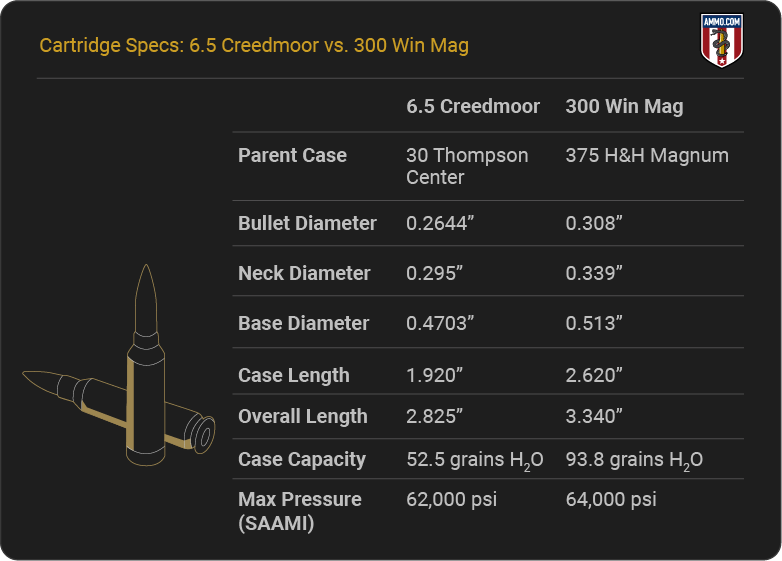
Recoil: 6.5 Creedmoor vs. 300 Win Mag
I do not recommend either of these cartridges to a beginner because both have stout kick.
For most shooters, less is always better when it comes to recoil. The lower the recoil, the lower the discomfort. Lower recoil also produces less muzzle rise, which shortens the amount of time the shooter has to spend restoring their aim on target. Lower recoil often causes the shooter to flinch less while firing, which does even more to promote better accuracy.
The amount of recoil a shooter actually feels is subjective. Basing any comparison on felt recoil would therefore be pointless. Free recoil energy, on the other hand, is purely objective, as it is the product of four measurable variables: projectile weight, propellant weight, muzzle velocity, and firearm weight.
6.5 Creedmoor free recoil is about 18.5 ft-lbs (143 grain bullet, 2,650 fps muzzle velocity, 8-pound rifle). That’s not light like the 5.56 NATO, but it’s also not a shoulder bruiser.
300 Win Mag free recoil is about 31.5 ft-lbs (180 grain bullet, 2,960 fps muzzle velocity, 8-pound rifle). The magnum cartridge approaches shoulder-bruising territory for many shooters, which is why 300 Win Mag rifles are frequently outfitted with muzzle brakes.
The 6.5 Creedmoor’s significantly lower recoil wins this section.
Trajectory
A “trajectory” is a bullet’s flight path as it travels downrange. It is measured in inches of bullet drop or minutes of angle (MOA). When its target is nearby, a bullet’s trajectory appears as a flat line: the result of gravity having relatively little time to affect the bullet. But when a bullet travels a long distance, its trajectory resembles an arch: rising and then falling, just like a baseball thrown from outfield.
A flatter trajectory is preferable for covering long distances, as it requires the shooter to make fewer adjustments to remain accurate.
A cartridge’s trajectory varies from load to load. For example, a 6.5 Creedmoor 143 grain ELD-X bullet drops -44.4” at 500 yards when zeroed in at 200 yards. A 95 grain V-MAX will drop only -34.8” at 500 yards when sighted in at 200 yards.
A 300 Win Mag 150 grain TTSX BT drops 32.96” at 500 yards when zeroed in at 200 yards. A 180 grain Ballistic Tip drops 38.78” at 500 yards when zeroed in at 200 yards.
The 300 Win Mag’s flatter trajectory wins this section. The magnum round’s projectiles are usually heavier, but its ferocious power throws its bullets far faster than the (comparably feeble) 6.5 Creedmoor can manage.
Accuracy: 300 Win Mag vs. 6.5 Creedmoor
Accuracy isn’t solely determined by the cartridge. The shooter, rifle, and atmospheric conditions also enter heavily into play.
At shorter distances, most shooters find that the 6.5 Creedmoor is more accurate due to its lesser recoil. However, at longer ranges, the 300 Win Mag gains the advantage courtesy of its flatter trajectory.
This section is a tie. Too many factors determine which of two cartridges (if either) is more “accurate” than the other.
Ballistic Coefficient
Ballistic coefficient (BC) reflects how efficiently a bullet overcomes wind drift and frontal air resistance. Put another way, it’s a numeric representation of a projectile's aerodynamic efficiency. A high BC is preferable because the bullet pierces the air more efficiently.
Ballistic coefficient varies considerably based on bullet design and several other factors beyond the scope of this article. That said, a heavier, sleeker bullet tends to have a higher BC, as it takes more force to disrupt its flight than that of a lighter, stubbier one.
The 6.5 Creedmoor 140 grain ELD Match has a 0.646 G1 BC; the 147 grain ELD Match bullet, 0.697 G1 BC. These are respectable BCs in light of the 6.5 Creedmoor’s other characteristics: a major reason why the round is heavily favored among long-range shooting enthusiasts.
The 300 Win Mag 180 grain TSX has a 0.453 G1 BC; the 200 grain ELD-X has a 0.597 G1 BC. Despite having heavier projectiles and higher muzzle velocities, the 300 Win Mag’s BCs are lower than those of the 6.5 Creedmoor. Its wider, less aerodynamic .30 caliber bullets are to blame for the disparity.
The 6.5 Creedmoor wins this section.
Barrel Life
Long-range precision shooters demand the pinnacles of accuracy and consistency from their rifles. These marksmen track the lifespans of their barrels closely, as they will fire tens of thousands – if not hundreds of thousands of rounds – over the course of their lives. (Worry not. If you only hunt and shoot targets casually, then you are unlikely to “burn” through a barrel.)
The most significant factor affecting a barrel lifespan is its cartridge’s propellant charge. A more powerful propellant charge typically shortens the barrel’s lifespan.
The 6.5 Creedmoor’s barrel life ranges from 2,500 to 3,000 rounds, which isn’t bad at all. A 300 Win Mag barrel, on the other hand, would be lucky to last half that many rounds; 1,000 to 1,200 is a reasonable estimate.
The 6.5 Creedmoor wins this section by a substantial margin.
Stopping Power: 6.5 Creedmoor vs. 300 Winchester Magnum
“Stopping power” means different things to different shooters, making it a term to define. Rather than argue about the correct definition, let’s save time by assuming that penetration depth, wound column diameter, and kinetic energy transfer are the primary contributors to stopping power.
Shot placement is more critical than stopping power. A poor shot from a powerful cartridge can prove less effective than a perfect shot with a weak one.
That aside, the 300 Win Mag has more stopping power than the 6.5 Creedmoor. Its wider, heavier, and faster-moving bullets boast higher striking energy at the same range and tend to inflict wider, deeper wound channels.
Hunters often critique the 6.5 Creedmoor’s lack of stopping power, but we’ll soon show that it’s more than capable of harvesting big game. Regardless, the 300 Win Mag wins this section.
Hunting
Both cartridges are good choices for hunting medium and large game, but each excels at harvesting specific species.
The 6.5 Creedmoor is better for wild hogs, whitetail deer, or mule deer hunting, as it damages less meat and is easier on the shoulder.
The 300 Win Mag is better for large game such as bear, elk, and moose – especially at farther distances (500+ yards).
This section is a tie, as it ultimately depends on the species you’re pursuing.
Ammo and Rifle Cost and Availability
The 300 Win Mag is a magnum cartridge. It is large, and therefore requires relatively more raw materials for its manufacture. Its greater length and power also necessitate the design of larger and more robust rifles. As you’ve likely already intuited, preferring 300 Win Mag over 6.5 Creedmoor will cost you.
At the time of writing, 6.5 Creedmoor ammo costs around $0.90 to $2.75 per round. 300 Win Mag ammo costs around $1.25 to $3.00 per round.
The 6.5 Creedmoor’s cheaper ammo and rifles win this section. And because it’s more popular, you’ll also find a greater selection of 6.5 Creedmoor ammo for sale.
Reloadability
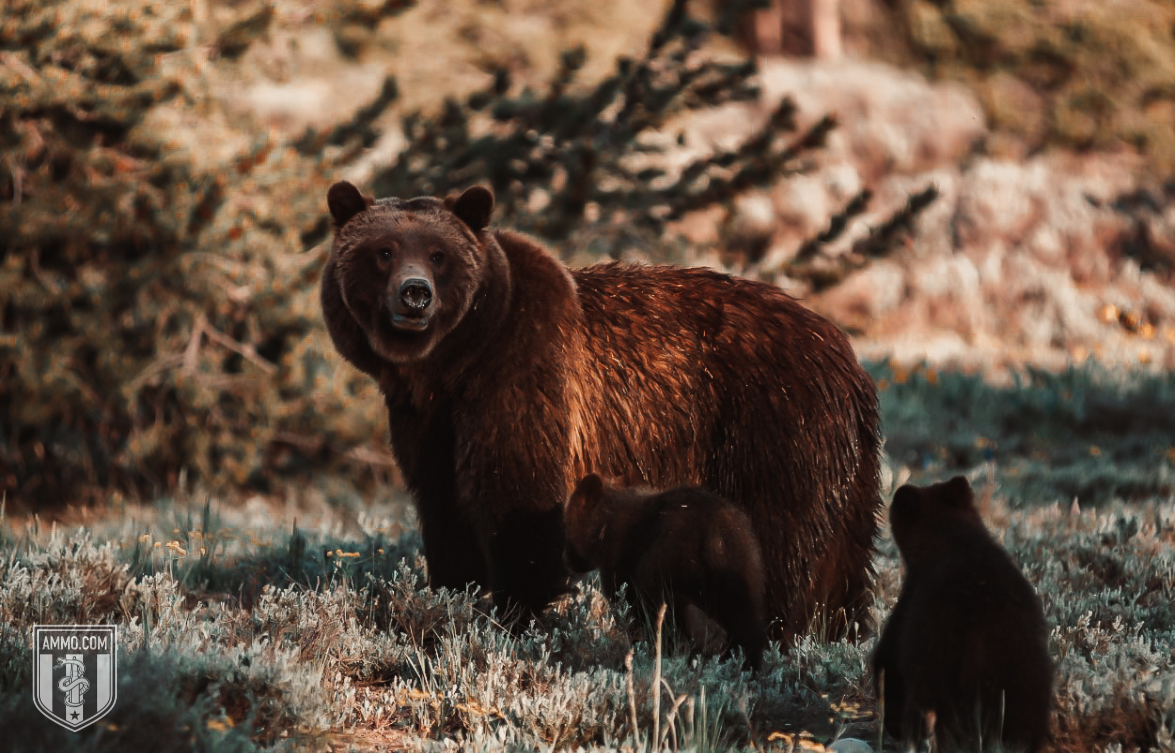
Handloading is the best way to craft the perfect ammo for your rifle and save money. The initial cost of buying reloading equipment and supplies is enough to keep most shooters at bay, but reloading is the only way for competitive and serious shooters.
Both rifle cartridges are reloadable. Plenty of reloading supplies and data are available for either, making this section a tie.
Ballistics
The team at Ammo.com has gathered ballistic data for both cartridges so you can compare them quickly.
6.5 Creedmoor Ballistics
Note: This information comes from manufacturers. Actual ballistics obtained with your firearm can vary considerably from those which are advertised. Ballistics also vary from lot to lot within the same brand and load type.
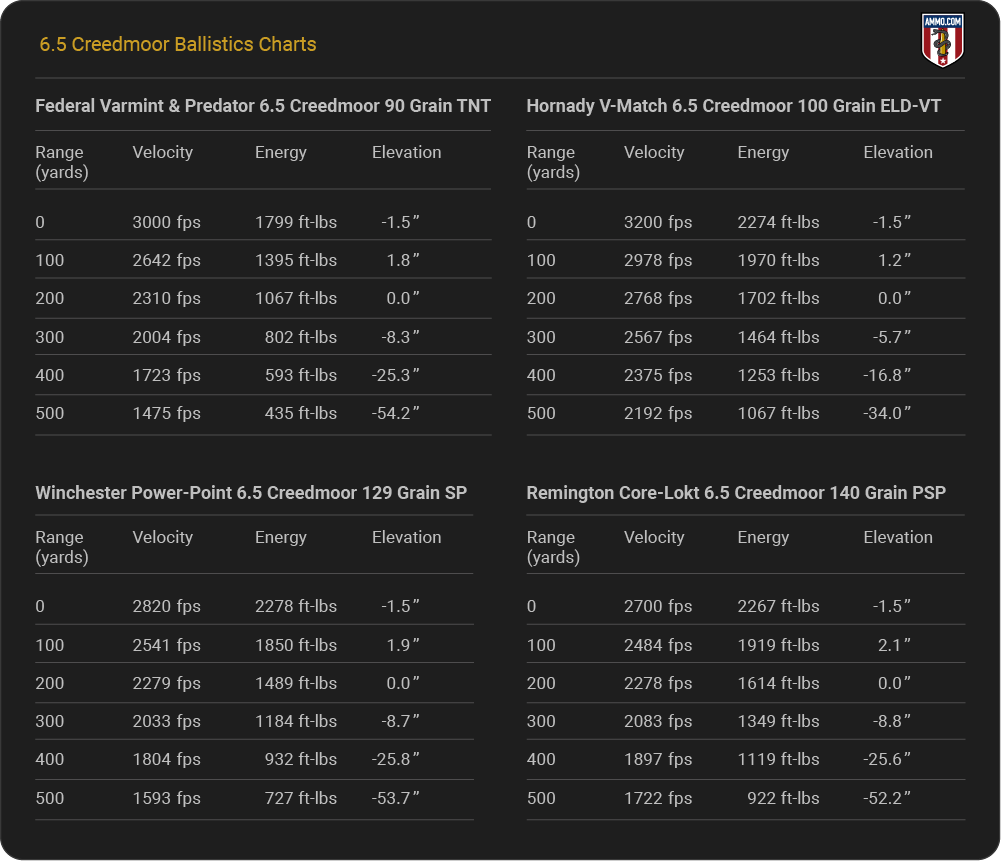
Take a deep dive into 6.5 Creedmoor ballistics for factory ammo.
300 Winchester Magnum Ballistics
Note: This information comes from the manufacturer. The actual ballistics obtained with your firearm can vary considerably from the advertised ballistics. Also, ballistics can vary from lot to lot with the same brand and type load.
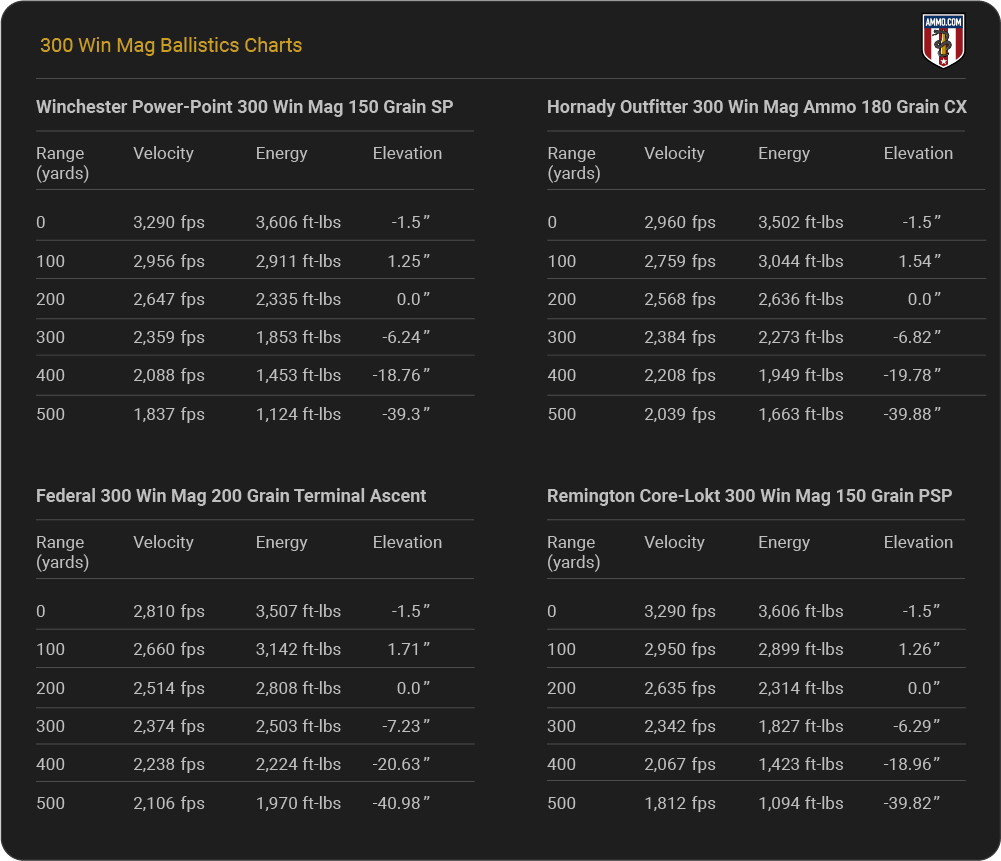
Take a deep dive into 300 Win Mag ballistics for factory loads.
6.5 Creedmoor Brief History
Hornady unveiled the 6.5 Creedmoor at the 2007 SHOT Show, unaware of how massive a success it would become within the long-range shooting community.
The 6.5 Creedmoor is loaded with several bullet weights, typically separated into two categories: lightweight, which ranges from 127 to 135 grains, and heavyweight, which is loaded with 140 to 147 grain bullets. Heavyweight projectiles have high BCs, making them a primary choice among many competitive long-distance shooters.
The rim of the 6.5 Creedmoor is identical to that of the 308 Winchester, which means a barrel change is all that is needed to convert a rifle chambered for one to the other. The 6.5 Creedmoor remains a fan favorite for long-distance target shooting competitions, and is gaining popularity among big-game hunters who target deer, pronghorn, and even elk.
300 Win Mag Brief History
Introduced in the 1960s, the .300 Winchester Magnum is a descendant of the legendary 375 H&H Magnum. Its ability to take down any animal in North America helped the .300 Win Mag quickly gain popularity among big game hunters. Competitive shooters also approved of the 300 Win Mag due to its flatter trajectory compared to the 308 Win.
The U.S. Army converted its sniper rifles from .308 Winchester to .300 WM because it is effective at neutralizing human-size targets up to 1,200 meters away. That's 50% farther than the reach of the .308 Winchester, which is by no means an ineffective sniper rifle cartridge by contemporary standards. Though the 6.5 Creedmoor has replaced the 300 Win Mag in some sniper applications, it remains a top choice for long-distance big game hunters and shooters.
Parting Shots
Now that you’ve finished our 6.5 Creedmoor vs. 300 Win Mag comparison article, you know that the 6.5 Creedmoor won four sections (recoil, BC, barrel life, and overall cost). Three sections were ties (accuracy, hunting, and reloadability). The 300 Win Mag won two sections (trajectory and stopping power).
The 6.5 Creedmoor is the better option for most shooters, as it’s less expensive, easier on the shoulder, and has a much longer barrel life.
The 300 Win Mag is better for the dedicated big game hunter or long-range shooter who needs extra range and is unfazed by higher cost and recoil.
Frequently Asked Questions
The team at Ammo.com has gathered and answered some commonly asked questions regarding 6.5 Creedmoor vs. 300 Win Mag.
Is A 300 Win Mag More Powerful Than A 6.5 Creedmoor?
Yes, a 300 Win Mag is more powerful than a 6.5 Creedmoor.
What Are The Primary Differences In Recoil And Cost Between 6.5 Creedmoor And 300 Win Mag?
The primary differences in recoil and cost between 6.5 Creedmoor and 300 Win Mag are drastic. The 300 Win Mag has nearly double the amount of recoil as the 6.5 Creedmoor and ammo currently costs about $0.40 to $0.50 more per round.
Does The Military Use 6.5 Creedmoor?
Yes, the military uses 6.5 Creedmoor in some sniper systems and in other small arms.
Ammo Comparisons
- .308 vs 5.56
- 6.5 Creedmoor vs .308
- .300 Blackout vs .308
- .300 Win Mag vs .308
- .243 vs .308
- .308 vs .30-06
- 7mm-08 vs .308
- .270 vs .308
- 7.62x39 vs .308
- .223 vs .308
- .338 Lapua vs .308
- .380 ACP vs 9mm
- .223 vs 5.56
- .300 Blackout vs 5.56
- 9mm vs 45 ACP
- 9mm vs 40 S&W
- .357 SIG vs 9mm
- 10mm vs 9mm
- 9mm vs 9mm Luger
- .243 vs .270
- .300 Win Mag vs .30-06
- .270 vs .30-06
- .40 vs .45
- 38 Special vs 357
- 9mm vs 40 vs 45
- 5.56 vs 7.62x39
- 338 Lapua vs .30-06
- .30-30 vs .30-06
- 300 PRC vs 338 Lapua
- .30-06 vs 7mm
- 300 Win Mag vs 338 Lapua
- 300 PRC vs 300 Win Mag
- 300 WSM vs 300 Win Mag
- 338 Win Mag vs 338 Lapua
- 12 Gauge vs 20 Gauge
- 10mm vs 357 Mag
- .30-30 vs 7.62x39
- 224 Valkyrie vs 22-250
- 17 HMR vs 22 Mag
- 7.62x39 vs .300 Blackout
- 45 ACP vs 45 Auto
- 45-70 vs 30-30
- 300 Blackout vs 223
- 357 Magnum vs 9mm
- 350 Legend vs 300 Blackout
- 224 Valkyrie vs 223
- 45 ACP vs 38 Super
- 6.5 Grendel vs .308
- 17 HMR vs 22 LR
- 10 Gauge vs 12 Gauge
- 22-250 vs 223
- 45 Colt vs 45 ACP
- 350 Legend vs 30-30
- 5.7x28 vs 223
- 5.7 vs 9mm
- 5.56 vs 5.7
- 22 vs 9mm
- Buckshot vs Birdshot
- 450 Bushmaster vs 308
- 450 Bushmaster vs 223
- Buckshot vs Slug
- 6.5 Grendel vs 5.56 vs 223
- 6mm ARC vs 6.5 Grendel
- 44 vs 45
- 458 SOCOM vs 5.56
- 357 vs 44
- 32 ACP vs 380
- 300 Win Mag vs 338 Win Mag vs 338 Lapua Mag
- 450 Bushmaster vs 458 SOCOM vs 50 Beowulf
- 6mm Creedmoor vs 6.5 Creedmoor
- TMJ vs FMJ
- 44 Special Vs 44 Magnum
- 45 90 vs 45 70
- 6.8 Western vs 6.8 SPC
- 50 Beowulf vs 50 BMG
- 26 Nosler vs 6.5 PRC
- 28 Gauge vs 410
- 6.8 SPC vs 5.56
- 6.8 SPC vs 6.5 Grendel
- 6.8 Western vs 7mm Rem Mag vs .28 Nosler
- 6.8 Western vs 6.5 Creedmoor
- 22 Hornet vs 223
- 6.8 Western vs 6.5 PRC
- .410 vs 12 Gauge
- .410 vs 20 Gauge
- 22 LR vs 22 Mag
- 6mm ARC vs 243
- 7mm-08 vs 270
- 243 vs 6.5 Creedmoor
- Nickel vs Brass Casing
- 204 Ruger vs 223
- 50 Beowulf vs 5.56
- 260 Remington vs 6.5 Creedmoor
- 6mm Remington vs 243
- 28 Nosler vs 300 PRC
- 50 Beowulf vs 50 AE
- 22 Nosler vs 22-250
- 450 Marlin vs 45-70
- 300 Win Mag vs 300 Norma
- 458 SOCOM vs 300 Blackout
- 38-55 vs 45-70
- 22 Hornet vs 22 LR
- 300 Norma vs 338 Lapua
- 338 Lapua vs 50 BMG
- 28 Nosler vs 300 Win Mag
- 28 Nosler vs 6.5 Creedmoor
- 204 vs 22-250
- 458 SOCOM vs 45 70
- 44 40 vs 45 70
- 6.8 SPC vs 6.5 Creedmoor
- 450 Bushmaster vs 30-06
- 7mm Rem Mag vs 300 Win Mag
- 30 Carbine vs 223
- 25-06 vs 30-06
- 26 Nosler vs 28 Nosler
- 16ga vs 12ga
- 30 06 vs 7.62 x54R
- 9mm Makarov vs 9mm Luger
- 350 Legend vs 223
- 30 Carbine vs 5.56
- 6.5x55 vs 6.5 Creedmoor
- 6.5 Creedmoor vs 270 vs 25-06
- M193 vs M855
- 450 Bushmaster vs 458 SOCOM
- 6.5 Grendel vs 6.5 Creedmoor
- 350 Legend vs 5.56
- .277 Fury vs 6.8 SPC
- 277 Fury vs 300 Win Mag
- 10mm vs .45 ACP
- 277 Fury vs 223
- 6.8 SPC vs 300 Blackout
- 6.5 PRC vs 6.5 Creedmoor
- 277 Fury vs 308
- 277 Fury vs 6.5 Creedmoor
- 350 Legend vs 450 Bushmaster
- 277 Fury Vs 5.56 NATO
- 10mm vs 40S&W
- 32 ACP vs 9mm
- 32 Special vs 9mm
- 8.6 Blackout vs 300 Blackout
- 30 Super Carry vs. 9mm
- 5.56 vs 9mm
- .50 Action Express vs 9mm
- 7.62x25 vs. 9mm
- 10mm vs 44 Magnum
- 300 Blackout vs 300 Win Mag
- 6.5 Grendel vs 300 Blackout
- 460 Rowland vs 10mm
- 300 RUM vs 300 PRC
- 300 Norma vs 300 PRC
- 45 GAP vs 45 ACP
- 7mm PRC vs 300 Win Mag
- 300 PRC vs 6.5 Creedmoor
- 300 PRC vs 308
- 357 SIG vs 357 Mag
- 7.62x39 vs 7.62x51
- 243 Win vs 223 Rem
- 30 Nosler vs 300 PRC
- 6.5 Creedmoor vs. 30-06 Springfield
- 450 S&W vs. 44 Magnum
- 6.5 Creedmoor vs. 300 Win Mag
- 454 Cassull vs. 45-70 Govt
- 454 Cassull vs. 44 Mag
- 7.62x54r vs. 308 Winchester
- 22 ARC vs. 223 Rem
- Subsonic vs. Supersonic Ammo
